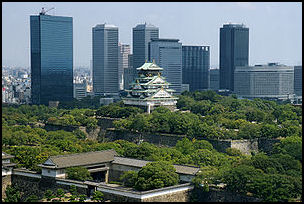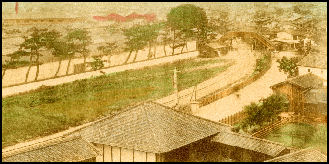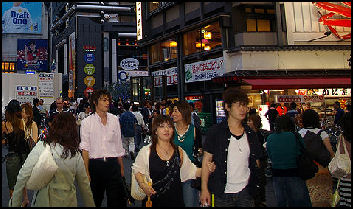OSAKA

OSAKA (about 500 kilometers southwest of Tokyo) is the second largest city in Japan and the 13th largest city in the world, with a population of about 10.5 million people. Situated on a sheltered bay, it is also the commercial, shipping and industrial center of western Japan, the second major gateway to Japan after Tokyo and the transportation and communication hub of the Kansai region, with a convenient connections to Kyoto, Nara, and Kobe, the Inland Sea area, and Shikoku, which are all nearby. Even though Osaka is flat as flat can be its name means “big hill.” The designated city of Osaka covers 222 square kilometers and has about 2.7 million people. The Metro area has almost 20 million people.
For the most part, Osaka isn't a very attractive place. Sometimes it seems like an endless concrete jungle of crowded streets and sidewalks, train lines, factories, office buildings, pre-fab homes and apartments squeezed much too close together. There isn't all that much to see, The main tourist sights include a concrete castle, an ultra-modern aquarium with a whale shark and the first Universal Studio to open up outside the United States. Foreign guide books often do not have much nice to say about Osaka. One said its biggest claims to fame were the yakuza and pachinko. Another called it the “Elephant Man” of Japan — ugly but wanting desperately to be loved.
Even so, if you have the choice of visiting Tokyo or Osaka, in many ways Osaka is a better. It is close to Kyoto, Nara and the heartland of Japan, and it offers fascinating glimpses of Japanese urban life: four-story office buildings under 12-lane expressways; multistory buildings with Ferris wheels and amusement parks on the roof; and subterranean shopping malls that pumped their sewage up and are so large you have occasionally go above ground to see where you are. The entertainment districts are full of bars and sex clubs. And we cann’t t forget the restaurants. Osaka has a reputation for having the best food in Japan.
Many say Osaka has retained far more of its historical look, feel and character than Tokyo and what is exciting about Osaka is that this feel and character is alive in its huge shopping and entertainment districts, where thousands of shops, restaurants and bars carry on the traditions of the past. Osaka made not be as well-known, rich and flashy as Tokyo but Osakans will tell you that it is a more real, honest, friendly and earthy place with a deeper history and a richer sense of humor and fun. Many say it is the heart of Japan. The people may be a little crude, inconsiderate and pushy at times, yes, but they are also more warm, open and generous. Many of Japan’s funniest comedians are from Osaka.
See Separate Articles: OSAKA TOURISM, ENTERTAINMENT, SHOPPING AND TRANSPORT factsanddetails.com ; OSAKA DISTRICTS AND ENTERTAINMENT AREAS factsanddetails.com ; OSAKA SIGHTS: OSAKA'S CASTLE AND AQUARIUM, TEMPLES AND KOFUN factsanddetails.com ; INTERESTING MUSEUMS AND FACTORY TOURS IN OSAKA factsanddetails.com ; OSAKA THEME PARKS AND AMUSEMENTS factsanddetails.com
Kansai and Kinki

Kansai The terms Kansai and Kinki are both used to refers to the general Osaka, Kyoto and Kobe area. Kansai is a more general term used to describe the area centering roughly on the cities of Osaka, Kyoto, and Kobe. While Kinki has well-defined borders and is an official geographical designation.
Kansai means "West of the Barrier." Kansai is used in a cultural and historic context, and in contradistinction to Kanto. People living in this region are said to speak with a Kansai accent, for example. Located well south of Mt. Fuji and the Japanese Alps, Kansai is both a booming industrial area and the cradle of ancient Japanese culture. Kansai people are regarded as friendlier, less busy, more business-minded and more irreverent than people from Tokyo. The Kansai dialect is very different from the Tokyo dialect. Many comedians come from Kansai. With the opening of the Kansai International Airport in 1994 the region is now considered a gateway to Japan. Website: Wikipedia Wikipedia
Kinki is a more geographically precise term that describes the prefectures of Kyoto, Osaka, Nara, Mie, Shiga, Kobe, Hyogo and Wakayama. It is home to more than 25 million people, or 20 percent of Japan's population and accounts for nearly a fifth of the gross domestic product of Japan. It has an economic output of $800 billion (greater than all but a handful of nations in the world).
Osaka Prefecture
Osaka Prefecture covers 1,905 square kilometers (735 square miles), is home to about 8.9 million people and has a population density of 4,639 people per square kilometer. Osaka is the capital and largest city with about 2.7 million people. The prefecture is in the Kansai area near Kyoto on the central part of Honshu island and has five districts and 43 municipalities.
Osaka Prefecture and the Kansai region is one of the most important economic regions in the world. It economic output exceeds that of most European countries and equals that of Canada. Osaka Prefecture’s gross product is ¥37.98 trillion and its budget is ¥4.29 trillion. Osaka and the Kansai areawas the birthplace of many famous Japanese companies, including Panasonic, Sharp, Sanyo, Suntory, Asahi, Nintendo (in Kyoto) and Minolta. The approximately 85,000 manufacturing enterprises in Osaka prefecture employ more 1 million people and produce over $350 billion worth of goods annually.
Osaka Prefecture borders the prefectures of Hyogo and Kyoto to the north, Nara to the east and Wakayama to the south. The west is open to Osaka Bay. The Yodo and Yamato Rivers flow through the prefecture. Prior to the construction of Kansai International Airport, Osaka was the smallest prefecture in Japan. The artificial island on which the airport was built added enough area to make it slightly larger than Kagawa Prefecture. About 11 percent of the total land area of the prefecture is covered by natural parks
Osaka has four distinct seasons and the weather is comparable to that of New York or Washington D.C.. Summer is hot and humid with temperatures often reaching 35°C (95°F), Autumn is comfortable and the warm weather can coninue into November. Winter is cold, sunny and dry with occasional light snowfalls and temperature sometimes dropping below freezing. Spring is mild with scattered showers. Mid-June to mid-July is the rainy season. Typhoons can occur from May to November but are most common in August and September.
History of Osaka

Osaka in the 19th century Osaka has traditionally been regarded as a city of merchants while Tokyo traditionally has had a reputation of being a city of bureaucrats and samurai. Osaka is also noted as the birthplace of traditional Japanese theatricals like Kabuki and Bunraku puppet dramas and as the site of some of Japan's most important battles.
Osaka was originally called Naniwa. Since the A.D. 3rd century A.D., its location on a protected bay and navigable river system has made it a center of inland traffic for the Kansai region and coastal trade in Japan. For a long time Osaka was the major commercial center of Japan. Until the late 19th century, about 70 percent of the country’s wealth was concentrated in Osaka even though Tokyo was the capital.
Boyé Lafayette De Mente wrote in Japan Today: “Osaka has the oldest history and the greatest story of any of Japan’s leading cities. In the 7th and 8th century—some one thousand years before the appearance of Edo/Tokyo—Osaka was known as Naniwa and was the gateway through which the culture and technology of Korea and China flowed into Japan. It was also the port for envoys and commercial travelers to and from other Asia countries. [Source: Boyé Lafayette De Mente, Japan Today, August 7, 2011]
”In A.D. 645 Naniwa became the first permanent imperial capital of Japan. Prior to this the capital was moved each time a new emperor took over. During this era huge engineering projects were carried out to control and direct the flow of several rivers that dissected the area of the city. Canals were dug to connect the rivers and enhance the flow of goods and people within the city. Huge warehouses dotted the banks of the rivers and canals. A total of 808 bridges connected the land-sites of the city. During the clan wars that led to the victory of Ieyasu Tokugawa and the founding of the Tokugawa Shogunate in Edo (Tokyo) in 1603, Naniwa/Osaka would have become the shogunate capital if Tokugawa’s opponent, the Hideyoshi clan, had won the civil war.
“During the Tokugawa Shogunate (1603-1867), Osaka’s transportation needs were served by a fleet of river and canal boats that were owned and operated by families. The whole network was taken over by the city government in 1907 and turned into a public transportation system. During its peak the system had 31 piers in key areas of the city.”
By the 1920s, Tokyo began to catch up. After World War II, it surpassed Osaka as big companies began transferring their headquarters to Tokyo. As is true with Tokyo, the majority of Osaka’s historical monuments were destroyed during the firing bombing raids of World War II and the vast majority of the city has been rebuilt since the war. Osaka received worldwide attention in 1970 when it hosted a World Exposition. It wasn't damaged much by the 1995 Kobe earthquake even though Kobe is only 45 minutes away by train.
Osaka People

People from Osaka and Kansai are regarded as more outgoing, pragmatic, independent and irreverent than other Japanese particularly those from Tokyo. They are more likely to jaywalk, gamble, show their feelings, display rude or inconsiderate behavior, smoke in no smoking areas, and show disdain for bureaucracy and rules “Osaka-ban”, the Osaka dialect, is regarded as rough and crude by many other Japanese.
Osakans have been called the “Latins of Japan.” They produce many of Japan’s funniest comedians and are known for enjoying good food, wearing bright clothes, and hating Tokyo and Tokyoites. Their appetite for life is summed up by the local word “kuidaore” (literally “to eat yourself to bankruptcy”). There is also a more unsavory side to this. Osaka is No. 1 in purse snatching, train molesting and illegally parked cars.
When you ask a Tokyoite for directions they point in the direction. When you ask a Kansai person for directions they take you there. It has been said that Osakan friendliness has it roots in the absence of samurai and the presence of a large number of merchants. One Osakan told the Japan Times, "Merchants consider everyone a potential customer. They don't want to run the risk of losing you as a customer so they go out of their way to be friendly." The merchant class of Osaka stays alive in other ways. A common Osakan greeting is "Are you making any money?"
Osakans are very stubborn about keeping their dialects even after living years in Tokyo. The Osakan dialect is almost like the Japanese equivalent of cockney English. It is full of colorful expressions and is the source of amusement in many comedy routines. The preferred insult in the Tokyo area is “baka.” It roughly translates to “idiot.” In Osaka the preferred word is “ahoya,” which roughly means “foolish,” as in making mistakes that all people make at one time or another.
See Separate Article OSAKA VERSUS TOKYO AND REGIONAL DIFFERENCES IN JAPAN factsanddetails.com
Economy of Osaka, Kansai and Kinki
Osaka is one of the world's greatest commercial cities. Located Osaka at the center of the Kansai region, Japan's traditional heartland and its second largest economic center, Osaka's gross product is about US$200 billion and its government budget is about $3.5 billion. It can be is an expensive city. Some lists of the world’s most expensive cities put it right behind Tokyo. Osaka has a long association with business and economic activity. It's GNP is greater than that of Mexico and Canada and all but eight countries in the world.
Located in west central Honshu, the Kinki region is Japan’s second most important area in terms of industry and is especially known for chemicals, machinery, steel, and metal. Both the Tokaido Shinkansen and the Sanyo Shinkansen depart from and arrive at Shin-Osaka station (with the exception of some trains going from Tokyo through to Hakata, Kyushu, or Hiroshima) .
Osaka is Japan's second largest city. Kobe is one of Japan’s most important ports.. Kyoto, once the capital of Japan and the residence of emperors from 794 to 1868, is famous for its temples, shrines, and other historic sites, and is a virtual storehouse of officially designated National Treasures and Important Cultural Properties. As a noted tourist resort, Kyoto attracts millions of tourists every year, from throughout Japan and the world. The Historic Monuments of Ancient Kyoto were registered as a World Heritage site in 1994. Osaka is the financial center of western Japan and an industrial center as well. Rice, citrus fruit production, timber and fishing have traditionally been important to the region’s economy
Osaka’s Decline
In the early 2010s there was some discussion about designating Osaka a metropolis. According to the Yomiuri Shimbun. At that time there was a “strong sense of crisis over Osaka’s status. In the closing years of the Taisho period (1912-26), the population of Osaka city exceeded that of Tokyo, and people showed their respect to Osaka by calling the city Dai-Osaka (great Osaka) . However, the commercial city’s influence has declined rapidly in recent years, as the city lacks key industries that can lead to economic development. [Source: Yomiuri Shimbun, March 3, 2012]
“Osaka Prefecture’s gross nominal product was 37.98 trillion yen in fiscal 2008, the second-largest in the nation following Tokyo’s 89.71 trillion yen — but the figure was down 8.5 percent from fiscal 1996. One in 18 residents in Osaka city receive welfare benefits, the highest ratio in the nation.
”Among major companies capitalized at 10 billion yen or more, 99 of them were headquartered in Osaka in 1999, but the figure dropped to 72 in 2009. The main reason for the decrease is attributed to overconcentration in Tokyo, and it is not clear whether the "ineffective governing system" caused by the coexistence of Osaka’s prefectural and municipal governments contributed to the decrease.
”Osaka Mayor Toru Hashimoto attributed the decline of Osaka Prefecture to the lack of a "commander-in-chief" designing and promoting its urban development, as two huge government offices — one for the prefecture and the other for the city — coexist in the second-smallest prefecture in the country. Hashimoto thinks that if the power and revenue of the prefecture and the two ordinance-designated cities were integrated into one, it would be possible for the Osaka metropolis to develop railroads and roads more efficiently, which would lead to the revival of "great Osaka."”
Creating a 'Great Osaka' that Can Compete with Tokyo
Osaka Mayor Toru Hashimoto’s plan to integrate the prefectural and municipal governments of Osaka was implemented to "reinvigorate local areas by changing their governmental structures,” he said at a ceremony held in December 2011 to inaugurate the headquarters for the integration of the prefectural and municipal governments of Osaka. [Source: Yomiuri Shimbun, March 3, 2012]
“The headquarters was established by the two governments as the first step toward realizing Hashimoto’s plan to transform Osaka into a metropolitan administrative unit like Tokyo, following landslide victories by Hashimoto’s party in the Osaka gubernatorial and mayoral elections in November. Hashimoto, head of the Osaka Ishin no Kai (Osaka restoration group) party, won the mayoral election, while the party’s Secretary General Ichiro Matsui grabbed the Osaka governor spot.
“The integration headquarters will work comprehensively on industrial policies and urban development projects of Osaka Prefecture and Osaka city, among others, which had been undertaken separately by the prefectural and municipal governments. Its opening marks the first time a prefecture and an ordinance-designated city have established a joint policymaking institution.
“Hashimoto and Matsui plan to secure 400 billion yen annually through cost cuts, especially in areas such as the duplication of administrative tasks of the governments. They want to allocate the money to sectors expected to expand in the future at the integration headquarters, which some see as a precursor for the envisaged "Osaka metropolitan government." The prefectural and municipal governments of Osaka have decided to let the integration headquarters work on projects such as managing public hospitals and universities in an integrated manner; designing a redevelopment zone located in front of JR Osaka Station; and privatizing the Osaka municipal subway. Hashimoto and Matsui want to show the benefit of integrating the prefectural and municipal governments by achieving consistent results, gaining momentum to achieve their goal of creating the Osaka metropolis in the spring of 2015.
“After integration, the cities of Osaka and Sakai will be divided into 10 to 12 special administrative units (wards) with the heads of the units and assembly members elected by popular vote. The administrative units will be in charge of providing welfare, education and other public services.
“However, many officials of the Internal Affairs and Communications Ministry say a plan advocated by the association of mayors from ordinance-designated cities to give de facto independence to major cities is more realistic than Hashimoto’s Osaka metropolis project. Moreover, it is unclear whether there is a cause-and-effect relationship between the current central government’s system on big cities and their economic vitality.”
Image Sources: 1) Japanese Guest Houses 2) 4) 7) Wikipedia 3) Visualizing Culture, MIT Education 5) 6) 8) Osaka Visitor's Guide 7) Ray Kinnane 8) Osaka Visitor's Guide and Urban Rail
Text Sources: JNTO (Japan National Tourist Organization), Japan.org, Japan News, Japan Times, Yomiuri Shimbun, Japan Ministry of the Environment, UNESCO, Japan Guide website, Lonely Planet guides, New York Times, Washington Post, Los Angeles Times, National Geographic, The New Yorker, Bloomberg, Reuters, Associated Press, AFP, Compton's Encyclopedia and various books and other publications.
Updated in July 2020
